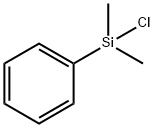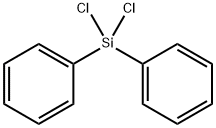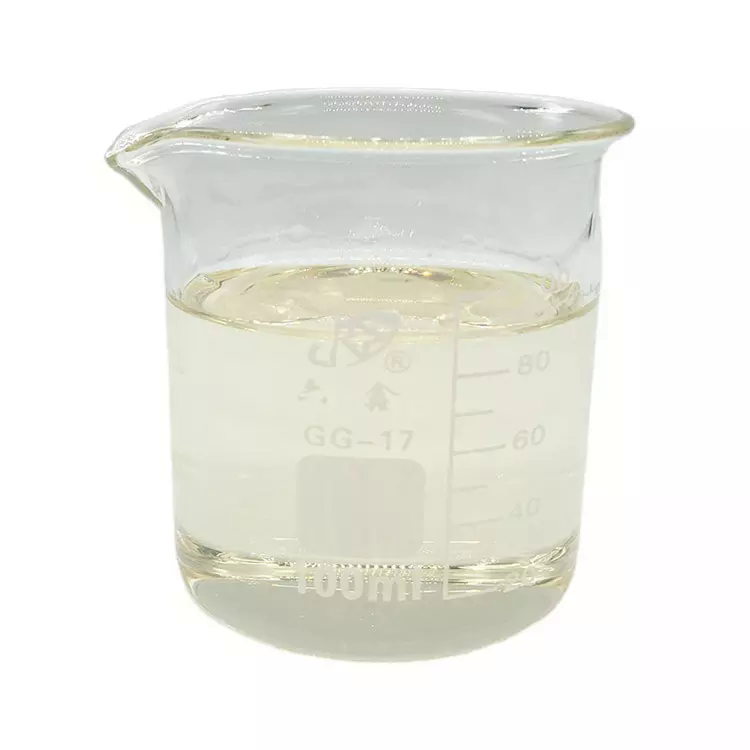Dichlorodimethylsilane
Synonym(s):Dichlorodimethylsilane;Dimethyldichlorosilane;DMDCS;Sylon CT;Silane M2
- CAS NO.:75-78-5
- Empirical Formula: C2H6Cl2Si
- Molecular Weight: 129.06
- MDL number: MFCD00000491
- EINECS: 200-901-0
- SAFETY DATA SHEET (SDS)
- Update Date: 2025-01-27 09:38:02

What is Dichlorodimethylsilane?
Description
Dimethyldichlorosilane is a colorless liquidwith sharp, irritating odor. Molecular weight= 129.07;Specific gravity = 1.07 at 25℃; Boiling point = 70.5℃;Melting point=86℃; Vapor pressure= 110 mmHg at20℃; Flash point = 27℃; Autoignition temperature=375℃. Explosive limits: LEL = 3.4%; UEL=9.5℃.Hazard Identification (based on NFPA-704 M Rating
Chemical properties
Colorless to brown liquid
Physical properties
mp ?76°C; bp 70–71°C; d 1.064 g cm?3.
The Uses of Dichlorodimethylsilane
Dichlorodimethylsilane can be used as additive for pinacol cyclization; protecting group for diols and
carbonyl compounds;precursor for a wide variety of siliconbased
reagents.
Dichlorodimethylsilane (1) allows clean
pinacol cyclization of a keto aldehyde to occur without competition
from an aldol reaction (eq 1).
The Uses of Dichlorodimethylsilane
Dichlorodimethylsilicon is a organosilicon compound and is the precursor to dimethylsilicone and polysilane compounds.
The Uses of Dichlorodimethylsilane
Dichlorodimethylsilane is used to prepare a resin bound siloxane with tertiary alcohols and it is also used as a reagent for synthesis of optically active ansa-mettallocene polymerization catalysts. It acts as a precursor to silicone and polysilane compounds. It is also used in the glass coating to protect it from micro particles. It is involved in the preparation of resin bound siloxane with reactivity towards tertiary alcohols.
Production Methods
Produced by the action of silicon on methyl chloride in presence of copper catalyst, or by Grignard reaction from methyl chloride and silicon tetrachloride.
General Description
A colorless fuming liquid with a pungent odor. Flash point 16°F. Vapor and liquid may cause burns. Denser than water. Vapors heavier than air.
Reactivity Profile
Chlorosilanes, such as Dichlorodimethylsilane, are compounds in which silicon is bonded to from one to four chlorine atoms with other bonds to hydrogen and/or alkyl groups. Chlorosilanes react with water, moist air, or steam to produce heat and toxic, corrosive fumes of hydrogen chloride. They may also produce flammable gaseous H2. They can serve as chlorination agents. Chlorosilanes react vigorously with both organic and inorganic acids and with bases to generate toxic or flammable gases.
Health Hazard
Inhalation irritates mucous membranes. Severe gastrointestinal damage may occur. Vapors cause severe eye and lung injury. Upon short contact, second and third degree burns may occur.
Fire Hazard
Vapor may explode if ignited in an enclosed area. Reacts vigorously with water to generate hydrogen chloride. Hydrogen chloride and phosgene gases may be formed upon heating or in fire. Runoff to sewer may create fire or explosion hazard.
Safety Profile
Poison by ingestion and intraperitoneal routes. Moderately toxic by inhalation. A skin and severe eye irritant. Violent reaction on contact with water. When heated to decomposition it emits toxic fumes of Cl-. See also CHLOROSILANES.
Potential Exposure
PrimaryIrritant. Used as an intermediate in the manufacture of silicone polymers.
First aid
If this chemical gets into the eyes, remove anycontact lenses at once and irrigate immediately for at least15 min, occasionally lifting upper and lower lids. Seek medical attention immediately. If this chemical contacts theskin, remove contaminated clothing and wash immediatelywith soap and water. Seek medical attention immediately. Ifthis chemical has been inhaled, remove from exposure,begin rescue breathing (using universal precautions, including resuscitation mask) if breathing has stopped and CPR ifheart action has stopped. Transfer promptly to a medicalfacility. When this chemical has been swallowed, get medical attention. If victim is conscious, administer water ormilk. Do not induce vomiting. Medical observation isrecommended for 2448 h after breathing overexposure, aspulmonary edema may be delayed. As first aid for pulmonary edema, a doctor or authorized paramedic may consideradministering a corticosteroid spray.
storage
(1) Color Code—Red: Flammability Hazard: Storein a flammable liquid storage area or approved cabinetaway from ignition sources and corrosive and reactivematerials. (2) Color Code—Blue: Health Hazard/Poison:Store in a secure poison location. Dimethyldichlorosilanemust be stored to avoid contact with oxidizers (such as perchlorates, peroxides, permanganates, chlorates, andnitrates), since violent reactions occur. Before entering confined space where this chemical may be present, check tomake sure that an explosive concentration does not exist.Store in tightly closed containers in a cool, well-ventilatedarea away from water, steam, or moisture, because toxicand corrosive hydrogen chloride gas can be produced. Donot store at temperatures above 50℃/122°F. Sources ofignition, such as smoking and open flames, are prohibitedwhere dimethyldichlorosilane is handled, used, or stored.Metal containers involving the transfer of 5 gallons or moreof dimethyldichlorosilane should be grounded and bonded.
Shipping
Dimethyldichlorosilane requires a shipping labelof “FLAMMABLE LIQUID, CORROSIVE.” It falls inHazard Class 3 and Packing Group II
Purification Methods
Other impurities are chlorinated silanes and methylsilanes. Fractionate it through a 3/8in diameter 7ft Stedman column (p 11) rated at 100 theoretical plates at almost total reflux. See purification of MeSiCl2. Solutions in heptane, 1,1,1-trichloroethane or 1-chloronaphthalene are used for the silanization of glassware and pipettes. [Sauer & Hadsell J Am Chem Soc 70 3590 1948, Beilstein 4 IV 4110.]
Incompatibilities
Forms explosive gas mixture with air.Water, steam, and moisture forms toxic and corrosivehydrogen chloride gas. Incompatible with acetone, amines,ammonia, alcohols, strong oxidizers, caustics. Attacks mostmetals. Do not store in temperatures above 122°F/50℃.
Properties of Dichlorodimethylsilane
| Melting point: | -76 °C |
| Boiling point: | 70 °C(lit.) |
| Density | 1.333 g/mL at 20 °C |
| vapor pressure | <200 hPa (20 °C) |
| refractive index | n |
| Flash point: | 3 °F |
| storage temp. | Store below +30°C. |
| solubility | sol chlorinated solvents and ethereal solvents; reacts
with protic solvents. |
| form | liquid |
| color | colorless |
| Specific Gravity | 1.0637 |
| explosive limit | 1.75-48.5%(V) |
| Water Solubility | reacts |
| Sensitive | Moisture Sensitive |
| Hydrolytic Sensitivity | 8: reacts rapidly with moisture, water, protic solvents |
| BRN | 605287 |
| Stability: | Stable. Reacts violently with water and alcohols. Highly flammable. Incompatible with strong oxidizing agents, water, alcohols, caustics, ammonia. |
| CAS DataBase Reference | 75-78-5(CAS DataBase Reference) |
| NIST Chemistry Reference | Silane, dichlorodimethyl-(75-78-5) |
| EPA Substance Registry System | Dimethyldichlorosilane (75-78-5) |
Safety information for Dichlorodimethylsilane
| Signal word | Danger |
| Pictogram(s) |
 Flame Flammables GHS02  Corrosion Corrosives GHS05  Exclamation Mark Irritant GHS07  Health Hazard GHS08 |
| GHS Hazard Statements |
H225:Flammable liquids H304:Aspiration hazard H314:Skin corrosion/irritation H336:Specific target organ toxicity,single exposure; Narcotic effects H373:Specific target organ toxicity, repeated exposure H412:Hazardous to the aquatic environment, long-term hazard |
| Precautionary Statement Codes |
P210:Keep away from heat/sparks/open flames/hot surfaces. — No smoking. P280:Wear protective gloves/protective clothing/eye protection/face protection. P301+P330+P331:IF SWALLOWED: Rinse mouth. Do NOT induce vomiting. P303+P361+P353:IF ON SKIN (or hair): Remove/Take off Immediately all contaminated clothing. Rinse SKIN with water/shower. P305+P351+P338:IF IN EYES: Rinse cautiously with water for several minutes. Remove contact lenses, if present and easy to do. Continuerinsing. |
Computed Descriptors for Dichlorodimethylsilane
New Products
Methyl (R)-1-Boc-4,4-difluoropyrrolidine-2-carboxylate 2,2-Difluoropropylamine hydrochloride tert-butyl 3-bromoazetidine-1-carboxylate (R)-1-Boc-3-hydroxypyrrolidine DIFLUOROACETIC ANHYDRIDE 2,2-Difluoropropionic acid Diallylamine, 99% Calcium hydroxide, 95% Aluminum oxide, basic 2-Bromophenylacetonitrile, 97% L-tert-Leucine,97% N-Hydroxy-2-methylpropanimidamide 4-(3,4-Dichlorophenyl)-3,4-Dihydro-N-Methyl-1-(2H)-Naphthalenimine (Schiff Base) 2-AMINO-3,5-DIBROMO BENZALDEHYDE [ADBA] L-Glutamic Acid Dimethyl Ester Hcl 10-Methoxy-5H-dibenz[b,f]azepine 5-Cyanophthalide N, N-Carbonyldiimidazole (CDI) Dibenzoyl Peroxide Titanium Dioxide 2-(Methylthio) Benzonitrile Sodium Acetate Anhydrous Allopurinol 1,5-DibromopentaneRelated products of tetrahydrofuran








You may like
-
 Dichlorodimethylsilane 95% CAS 75-78-5View Details
Dichlorodimethylsilane 95% CAS 75-78-5View Details
75-78-5 -
 Dichlorodimethylsilane CAS 75-78-5View Details
Dichlorodimethylsilane CAS 75-78-5View Details
75-78-5 -
 Dimethyl dichlorosilane, 98% CAS 75-78-5View Details
Dimethyl dichlorosilane, 98% CAS 75-78-5View Details
75-78-5 -
 Dichlorodimethylsilane CAS 75-78-5View Details
Dichlorodimethylsilane CAS 75-78-5View Details
75-78-5 -
 Dichlorodimethylsilane solution CAS 75-78-5View Details
Dichlorodimethylsilane solution CAS 75-78-5View Details
75-78-5 -
 Dichlorodimethylsilane 98%View Details
Dichlorodimethylsilane 98%View Details -
 Ethyl-2-Chloroacetoacetate 609-15-4View Details
Ethyl-2-Chloroacetoacetate 609-15-4View Details
609-15-4 -
 609-15-4View Details
609-15-4View Details
609-15-4
